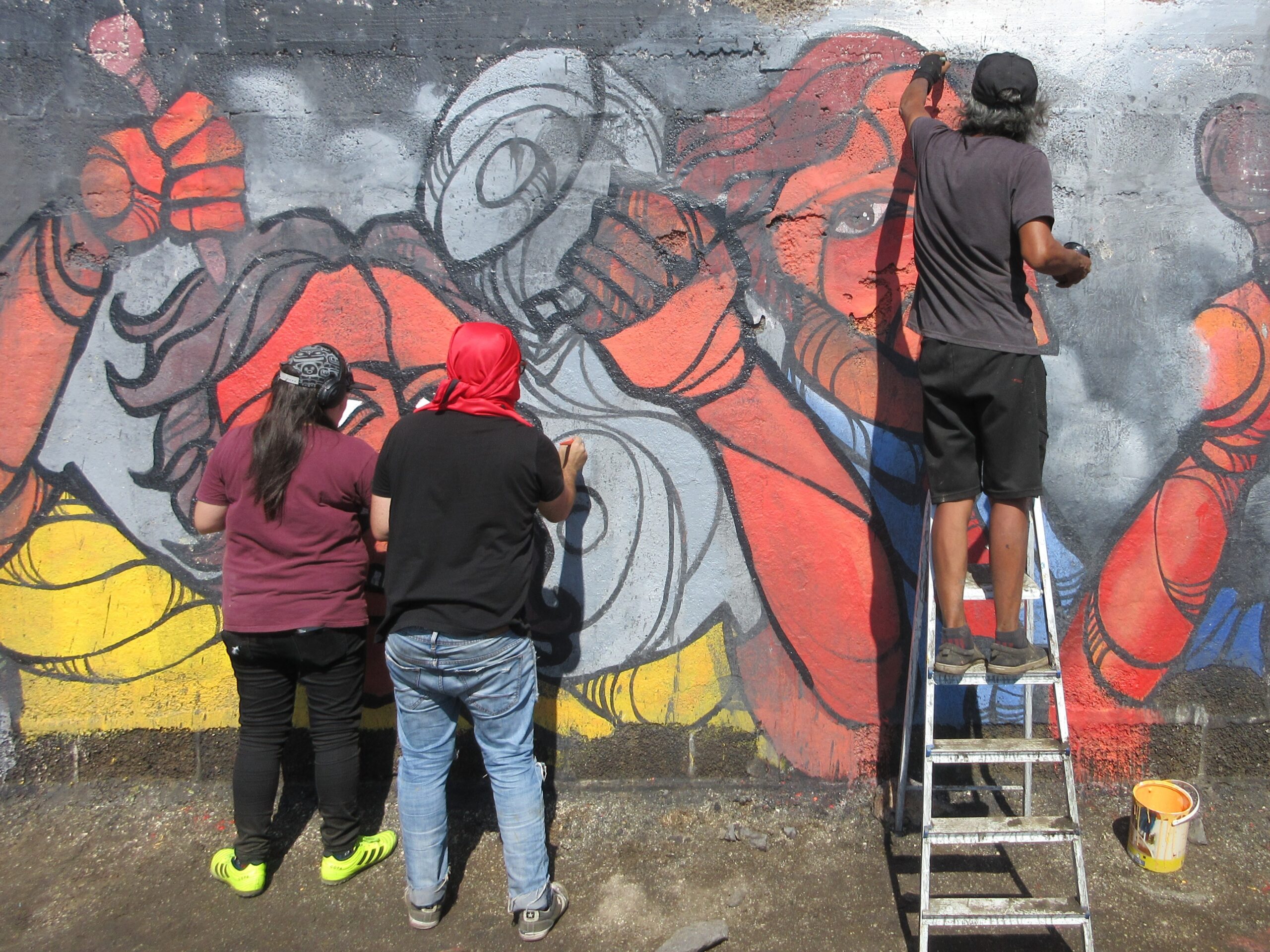
From Rebel Teas to Marching Bands: A Year of Protest Culture in Chile
ANTOFAGASTA – Raúl “Lito” Naverrete took a step back to evaluate the progress. More than a dozen volunteers showed up to help restore a community mural celebrating elements of the ongoing nationwide protests in Chile against structural inequality. Chilean hip hop protest anthems kept people energized as cars whizzed by behind them along a Pacific coastal boulevard in Antofagasta, 830 miles north of Santiago.
“Murals narrate the people’s history, the things [major newspapers] don’t tell,” said Navarrete, who designed the mural.
For three decades, Navarrete has worked on more than 100 murals up and down Chile, and this was the first time one had been defaced, he said. Overnight last December, the 200-foot-long mural had been covered in black paint, so people came together to scrub and restore the artwork, retouching details featuring frontline barricades, protest medics, eye injuries, lyrics to the LasTesis feminist performance against rape culture and more.
“This is all out,” Navarrete said of the protest movement. “We have to win.”
Oct. 18 marks one year of mass protests for systemic change in Chile, and one year of brutal repression. Street demonstrations in the capital continue to draw most of the attention, but they are just one part of a diverse and decentralized movement. It has also been a year filled with a resurgence of protest art and music, neighborhood organizing, feminist influences, city-specific forms of protest, local experiments in direct democracy, and mutual aid.
High school student actions last year were a match dropped onto the fuel of decades of widespread social discontent, and Chile erupted in what is known as the estallido social, which roughly translates to an explosion of social unrest. Grievances include the privatized pension system, the cost and quality of education and health care, resource extraction, repression, and the rejection of a deeply unequal, exclusionary and neoliberal state since the country’s return to electoral democracy following the 1973-1990 military dictatorship of General Augusto Pinochet.
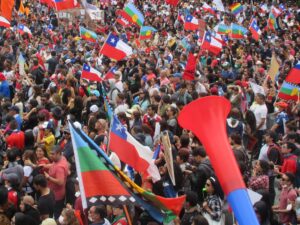
Thousands gather in Antofagasta’s “Plaza of the Revolution” to protest. (Photo: Sandra Cuffe)
Mass street protests raged for months up and down Chile, prompting President Sebastián Piñera to declare on more than one occasion, “we are at war with a powerful and relentless enemy.” At the outset of the protests and massive property damage, Piñera declared a state of emergency and deployed the military for nine days. Then and since, Chile’s national police force, known as the Carabineros, has engaged in violent crackdowns on protests.
The government response to protests produced the worst human rights abuses since the end of the military dictatorship, according to the National Human Rights Institute, an independent state institution. National and international human rights groups have documented thousands of abuses by security forces, including extrajudicial killings, sexual assault, torture and excessive use of force. Police pellet projectiles have caused hundreds of eye injuries.
“During this whole process of unrest, there are people who have died. There are people who have lost their eyes. Because of them, we can’t stop because we haven’t won anything yet. For that reason, we need to stay in the streets,” Roberto Cortés said at a late night protest in February in Antofagasta, as Carabineros began moving up the steep avenue, firing tear gas at protesters and dousing blazing barricades blocking intersections as they advanced under a volley of rocks thrown by protesters.
A 23-year-old primary school music teacher, Cortés is also an avid trumpet player, and he carried the instrument at protests without fail. Music has been a mainstay at demonstrations in Chile, with new protest songs as well as a resurgence of movement songs from decades past, particularly Victor Jara’s El derecho de vivir en paz (The right to live in peace) and Los Prisioneros’ El baile de los que sobran (The dance of those left behind). At protests in Antofagasta, both tunes and many others were brought to life by ever-shifting ensembles of brass and percussion musicians.
“Some of us knew each other beforehand, but most of us met at the protests,” Cortés said. “It makes the marches entertaining when we get started, but it’s also a way to express our discontent. As musicians, this – playing an instrument – is what we best know how to do, so we do it to express our discontent and also contribute by bringing joy to the marches.”
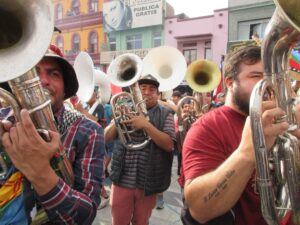
The brass section of a protest marching band enters Antofagasta’s “Plaza of the Revolution.” (Photo: Sandra Cuffe)
Cortés was looking forward to voting in favor of a new constitution. Originally scheduled for April, a nationwide referendum asking Chileans whether they want a constitutional convention and how it should be constituted was postponed to Oct. 25, due to the pandemic. ‘Yes’ to the constitutional convention is expected to win in a landslide, and if the all-citizen option is chosen over a mixed citizen-legislator body, an all-citizen assembly with 50% women could end up writing a new constitution that many hope could address the deep-rooted systemic inequality behind the unrest.
On a much more local level, people have been envisioning the change and world they want in neighborhoods around the country. At gatherings and grassroots assemblies, residents gathered for open or thematic discussions and to analyze the events unfolding around them.
A similar dynamic was evident at Tecito Rebelde actions. “Rebel Tea” demonstrations were community tea picnic sit-ins that very occasionally happened elsewhere but were a constant in Antofagasta. Some weeks saw multiple “Rebel Tea” actions around the city, sometimes with “Rebel Breakfast,” “Rebel Pasta,” and other sit-ins in the mix.
“It is a form of gathering but also of blocking the street,” Silvia Ascueta said. A 15-year-old high school student, she had organized a little Tecito Rebelde at the corner of her block in Antofagasta for a simple reason: her mom would not let her go to most protests, fearing they or ensuing repression might get out of hand. Sitting next to Ascueta, her mom smiled as her daughter explained that she was allowed to go to some of the bigger Tecito Rebelde actions and had decided to organize one of her own.
“Sometimes as youth we have to stand up and organize ourselves. Adults have normalized so much injustice,” Ascueta said at her Tecito Rebelde action in November, as neighbors began to stop by for some tea and conversation.
High school students had sparked the nationwide protests the previous month with subway fare evasion actions in Santiago to protest a later-nixed fare hike. The mobilizations did not come out of nowhere. Massive student protests rocked the country in 2006 and 2011, and high school and university student movements have remained active, staging protests, walkouts and months-long occupations.
Gabriela Soto, a geology student at the Catholic University of the North in Antofagasta, had participated in past student movements. But when women students began organizing among themselves in 2018 to fight sexual harassment, rape culture and impunity at their universities, she noticed a marked difference in organizing culture.
“It was not the same as in 2011,” Soto said, explaining that her experience years ago at student movement assemblies, including in Santiago, were often dominated by long-winded speeches, conflict and gendered dynamics. “There were always men who interrupt and speak over women,” she said.
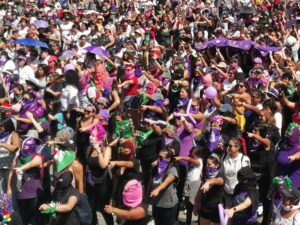
Women in Antofagasta perform “A Rapist in Your Path” by LasTesis. (Photo: Sandra Cuffe)
“We have a different way,” Soto said, noting that 2018 university women’s movements were all about horizontalism, respect and consensus. At her university, the movement won several important demands related to gender violence on campus, though their implementation by the administration is still a work in progress.
But Soto’s biggest takeaway from the experience was learning a new way of organizing, with the support of feminist groups, and being able to take that beyond the campus. Now also part of an intersectional and inter-organizational feminist coordinating space in Antofagasta, she has noticed the influence of horizontal feminist organizing in the broader protest movement, she said in a local plaza in March, just days before the March 8 International Women’s Day marches drew an estimated two million people around the country.
Along with the influence of horizontalism at the foundation of many feminist groups, the nationwide protest movement has also seen the creation of new structures and coordination spaces. In Antofagasta, the Comité de Emergencia y Resguardo (Emergency and Protection Committee) emerged last year on Oct. 21, when the army was still out in the streets enforcing a curfew.
“It is direct democracy,” said Natali Flores, a member of the Comité de Emergencia y Resguardo steering committee. Inside an occupied University of Antofagasta building last November, Flores sat next to a collection of tear gas canisters and police projectiles, including blanks and bullet casings, collected after a protest. The Comité has all-volunteer commissions for first aid, legal aid, mental health, education, arts and more, but all decisions emanate from the assembly.
The assembly unites people already part of formal unions, parties and activist groups with those who are not, including many individual protesters and residents of marginalized neighborhoods. Affiliations are checked at the door and each participant in the open assembly has an equal vote in decisions establishing common ground and determining united courses of action.
“Everyone is welcome,” Flores said, but after a pause, she added: “Except fascists.”
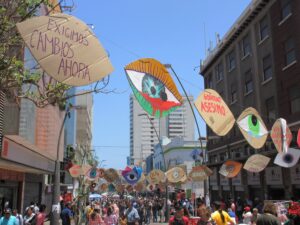
A protest art installation in Antofagasta draws attention to eye injuries. (Photo: Sandra Cuffe)
Protests are once again on the rise in Chile, as lockdown measures in place to manage the spread of COVID-19 are gradually being lifted around the country. Even when most people were taking a break from street demonstrations for public health reasons, though, the movement helped inspire local mutual aid efforts, including some of the hundreds of “olla común” grassroots neighborhood soup kitchens that sprang up all over Chile during the pandemic.
“We would have never thought of organizing something like this,” Pamela, a 20-year-old who requested only her first name be used, said in July as she helped out at an olla común in Antofagasta.
“It was organized thanks to the estallido social.”
Sandra Cuffe is a freelance journalist covering human rights, politics and social movements in Central America and sometimes beyond.